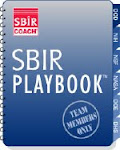.
The quick news is the informal conference committee hasn't done its job and no SBIR Reauthorization compromise was produced. SBIR (this time along with STTR and the DOD's CPP) has been extended again -- a mere month to October 31st. Gee. Is anybody surprised? We have a do-little-but-argue-and-sling-mud Congress. Maybe Dr. Dolittle is in charge.
Remember the Dr. Dolittle story? In the charming Hugh Lofting series of children's stories he was a doctor who eschewed human patients for animals, and he spoke their language. He lived in a fantasy world. Sort of like our Congress. But that's not why I'm raising this metaphor.
I have two reasons, actually. The first is his name -- irresistible!
The second is one of the animals he encounters -- the Pushmepullyou. It had two heads, was conflicted as to which direction to go, so had trouble going anywhere. Sort of like SBIR companies.
I was at the DOD's "Beyond Phase Two" (BP2) Conference this week. It was all about how to transition the technology created via SBIR funding into end use. I had a revelation. It finally dawned on me why SBIR commercialization is so hard to do.
SBIR has always been a technology push game. Techies rule. With some SBIR funding, create some whiz-bang technology and then try and find some applications for it.
I'm a Business Coach. I help companies focus on what it takes to be successful. A basic tenet I stress is "be selling something to a market pull". Find a market with a pain that is begging for a cure. Develop the cure. Sell the cure. It's so much easier than pushing a new technology on a resistant market.
Market pull vs. technology push. It's so basic. Think Pushmepullyou. The pull side should dominate. But it doesn't.
Where do SBIR topics come from? From my observation, in the DOD it's largely from their R&D shops. Techies. Looking for new technologies, to be developed by other techies. Yes, there are applications in mind. Certainly that's true. But the ultimate customer isn't involved. Projects are not market driven.
The DOD's Commercialization Pilot Program (CPP) is supposed to connect the SBIR company that's finished Phase II with the customer. That's probably the first time that the light of a market perspective is shined on this effort. For the most part, it's too late. It's still technology push.
There were several companies at the BP2 Conference who talked about their commercialization successes. I was struck with a common thread. In each case the companies had approached the process from the beginning with a marketing perspective. I was very proud. I had actually coached two of them.
If the DOD is to make the CPP (or whatever it evolves to) a success, it must offer more product-focused end user generated topics. Clearly identify market pull early on. Trying to push the technologies into possible applications after development just doesn't work very well. Pushmepullyou.
It comes down to this -- it's not about being funded to develop the technology, it's about selling something to a customer who will use it. Strategic planning focusing on that user customer from the start is the key.
My friend, and fellow SBIR consultant, Russ Farmer of PBC, summed this up well in his excellent presentation on the last morning of the Conference. Russ emphasized that SBIR commercialization success is "all about marketing!!" and "if we are real lucky" is not a business strategy.
Russ's presentation on Business Models of SBIR Funded Companies is a must read. Every SBIR company will see their stage of development profiled - and they probably won't much like what they see. A copy of it will be available for download from the BP2 Conference website by mid next week.
Will Congress get SBIR reauthorized by the end of October? I doubt it. Watch for yet a fifth CR extending the agony to next March.
I heard that a certain Congressperson was upset that I've been criticizing the Committee for being unwilling to compromise. There's a cure for that. Stop futzing around, reach a compromise and I'll stop criticizing! In the meantime, I'm pleased that someone from the Hill is actually reading this column!
.
Seasonal businesses: post signs year-round
4 days ago





 Join Email List
Join Email List





